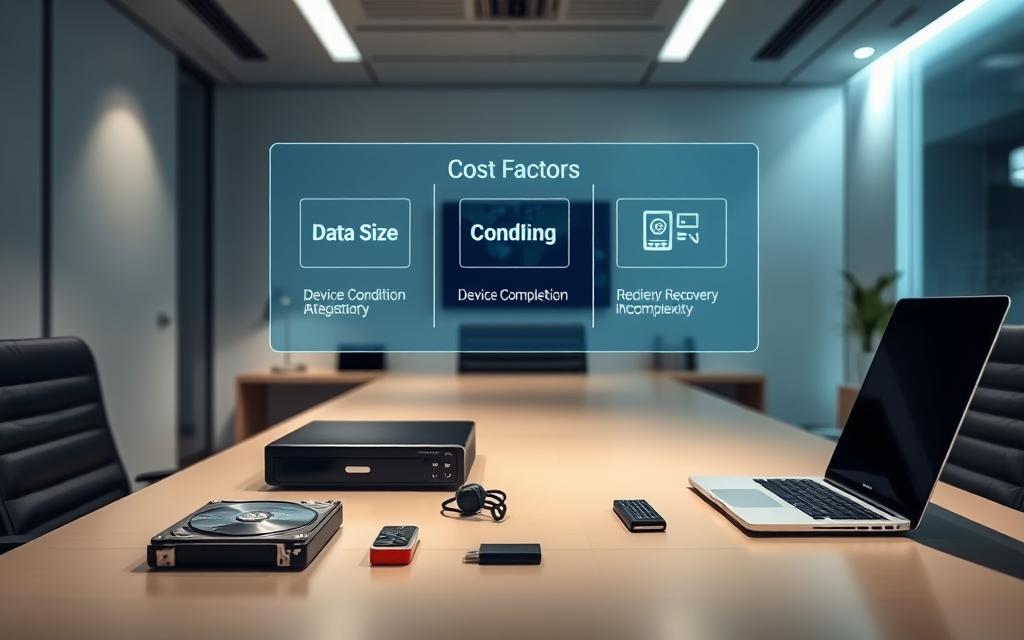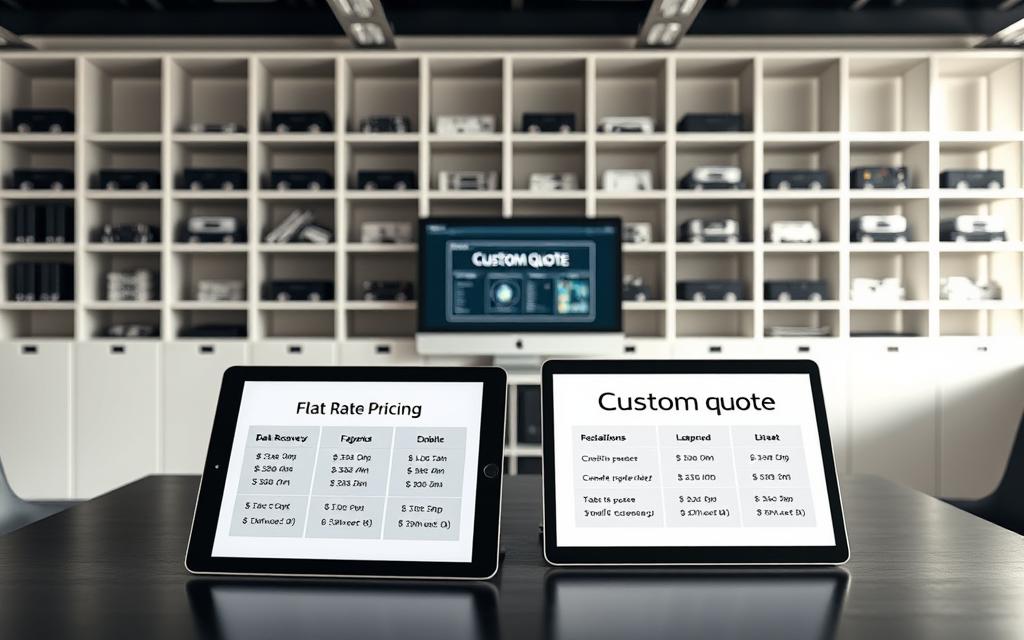When a hard drive fails or files become inaccessible, many people search for quick pricing answers. Unlike standard tech services, data recovery doesn’t follow fixed rates. Each case requires unique diagnostics to determine the solution.
Several factors influence the final cost, including device type (HDD vs. SSD), failure severity, and urgency. Reputable providers often use “No Data, No Charge” policies, ensuring you only pay for successful results.
Specialized tools, cleanroom facilities, and expert labor contribute to the process. Companies like Proven Data offer free quotes, transferring recovered files to new drives for security. Understanding these variables helps set realistic expectations.
Key Takeaways:
- Pricing varies based on diagnostics, not storage capacity
- Urgency and failure type significantly impact costs
- Trustworthy services provide transparent quotes upfront
How Expensive Is Data Recovery? Breaking Down the Basics
Many assume professional file restoration follows standard pricing models. However, each case presents unique challenges requiring customized solutions. Unlike buying storage space, you’re paying for specialized expertise and advanced technology.
Myth of Per-Gigabyte Pricing
The common misconception about paying per storage capacity doesn’t reflect reality. A 500GB drive with stuck heads often costs more to fix than a 2TB drive with logical errors. Service providers like Rossmann Repair Group demonstrate this through their tiered pricing:
| Issue Type | Typical Cost Range |
|---|---|
| Bad sectors | $100-$250 |
| Stuck heads | $300-$400 |
| Platter damage | $900+ |
Behind the Scenes: Expertise and Equipment
Certified technicians use specialized tools that significantly impact service quality. Cleanroom facilities for physical repairs can cost thousands to maintain. Forensic imaging tools and manufacturer-specific certifications add to operational expenses.
Logical failures typically start at $100-$300, while mechanical issues often exceed $900. The Rossmann Repair Group explains how different failure types create varying labor demands.
Professional solutions outperform DIY attempts in success rates. Free software might recover recently deleted files, but complex cases require trained specialists. The investment often proves worthwhile when dealing with irreplaceable information.
Key Factors That Influence Data Recovery Costs
Several critical elements determine the final price when restoring lost files. Understanding these variables helps set realistic expectations and avoids surprises. The device type, damage severity, and urgency level all play significant roles.

Type of Device: HDD vs. SSD vs. External Drives
Not all storage devices are created equal when it comes to restoration challenges. Traditional hard drives (HDDs) typically cost $100-$400 to repair, while SSDs range from $300-$1,000+ due to their complex architecture.
External drives add another layer of complexity. USB-SATA conversion issues often increase fees to $250-$650. As noted by industry experts, “SSD firmware repairs demand specialized tools that many labs don’t possess”, explaining the price difference.
| Device Type | Average Cost Range | Common Issues |
|---|---|---|
| HDD | $100-$400 | Stuck heads, bad sectors |
| SSD | $300-$1,000+ | Failed controllers, firmware corruption |
| External Drives | $250-$650 | Connection failures, enclosure damage |
Severity of Damage: Physical vs. Logical Failures
Physical damage dramatically increases restoration expenses compared to logical issues. A simple file corruption might cost $300, while platter repairs often exceed $900. Moisture exposure requires specialized drying protocols, adding to the total.
RAID arrays present unique challenges too. Reconstruction complexities can double standard service fees. Some manufacturers void warranties for unauthorized recovery attempts, creating additional considerations.
Turnaround Time: Standard vs. Emergency Services
Urgency comes at a premium. Standard services might take 3-5 business days, while 24/7 emergency options often double the baseline cost. Providers like SalvageData require upfront payment for rush jobs due to resource allocation needs.
For those needing SSD solutions, specialized SSD recovery services offer expertise with advanced flash storage systems. Their ISO-certified cleanrooms ensure proper handling of sensitive components.
“Time-sensitive recoveries demand round-the-clock staffing and priority lab access, which justifies the higher fees.”
Common Types of Hard Drive Failures and Their Costs
Storage devices fail in different ways, each requiring specific repair approaches. The recovery cost varies significantly depending on whether the issue is mechanical, logical, or malware-related. Professional labs like Rossmann Repair Group categorize these failures into distinct service tiers.
Mechanical Failures: Clicking Sounds and Stuck Heads
Physical damage often produces audible warnings like clicking or grinding. A stuck read/write head typically costs $300-$400 to repair, while full head replacements can exceed $2,000. Platter scratches demand cleanroom interventions averaging $900+.
These disk issues require donor parts and specialized tools. As one technician notes: “Head swaps on modern drives need exact model matches – sourcing these parts adds hours to the process.” Enterprise NAS systems often double these estimates due to RAID complexities.
Logical Failures: Corrupted Files and Accidental Deletion
Software-related issues generally cost less than mechanical repairs. Partition table fixes start at $100, while advanced file carving for lost data reaches $300+. Firmware corruption sits in the middle at $650 median cost.
| Issue Type | Time Required | Cost Range |
|---|---|---|
| Deleted files | 2-4 hours | $100-$250 |
| Formatted drive | 4-8 hours | $200-$400 |
| Bad sectors | 6-12 hours | $150-$1000+ |
Ransomware and Malware Damage
Cyberattacks create unique challenges for hard drive recovery. SalvageData reports $3,000 average decryption costs, while businesses face $16,000/minute downtime expenses. Specialized tools are needed to extract files without spreading infection.
Professional services outperform DIY attempts for malware cases. “Home software often overwrites critical sectors during recovery,” warns a forensic expert. Enterprise storage systems require additional quarantine protocols, adding to service time.
“Ransomware victims who pay for professional recovery typically regain 92% of files versus 47% with DIY methods.”
Flat Rate vs. Custom Quotes: How Pricing Models Differ
Pricing models for file restoration vary widely between providers. Some advertise fixed rates, while others tailor costs to your specific case. Knowing the differences helps avoid surprises and ensures fair pricing.

Hidden Fees in Flat-Rate Services
Flat-rate price structures often seem affordable at first glance. However, many include unexpected add-ons:
- Part replacement fees: Up to $500 for donor components.
- Non-refundable attempt charges: $1,000+ if initial efforts fail.
- Transfer media costs: External drives or cloud storage fees.
A case study revealed a $199 flat rate ballooning to $1,499 after diagnostics. Providers like SalvageData contrast this with free evaluations and transparent pricing.
Advantages of a Custom Diagnosis
Tailored quotes account for your device’s unique issues. Benefits include:
- Itemized breakdowns: Labor, parts, and cleanroom time detailed.
- No upfront payment: Pay only after successful restoration.
- Insurance documentation: Detailed reports for claims.
“Custom quotes reduce guesswork. You see exactly what you’re paying for.”
Forensic recoveries for legal cases often require custom pricing due to specialized tools. Cleanroom allocations are also factored in, ensuring accurate cost projections.
DIY Data Recovery Risks vs. Professional Services
Attempting DIY fixes for damaged storage devices often leads to irreversible consequences. SalvageData reports an 89% failure rate for physical damage cases when using home methods. What starts as a cost-saving effort can escalate into permanent data loss.

Free software tools lack the capability to address hardware failures. Water-damaged drives have a 0% success rate with DIY attempts. Logical recoveries risk overwriting files, worsening the original issue.
Rossmann Repair Group’s cleanroom facilities achieve 92% success rates for head replacements. In contrast, 63% of DIY head swaps result in unrecoverable damage. The $300 average professional fee often proves cheaper than failed attempts.
“Home methods frequently destroy delicate platters. Once scratched, even professionals can’t salvage the files.”
A $150 DIY attempt on a dropped drive cost one client $2,000 in professional salvage later. Certified tools and HEPA-filtered cleanrooms are necessities, not luxuries. For critical files, trust experts with years of specialized training.
Conclusion: Making an Informed Decision for Your Data
Choosing between DIY attempts and professional services depends on your situation. Business downtime costs average $547 per minute, making expert solutions cost-effective. Certified labs achieve 95% success rates versus 30% for home methods.
Consider the damage type, device value, and urgency. For critical files, immediate shutdown and expert help prevent further loss. Trusted providers offer warranties and compliance guarantees.
Compare quotes before deciding. A $3,000 recovery beats $250,000 ransomware payments. Prioritize security and success rates over upfront savings for peace of mind.
FAQ
Why does pricing vary so much for retrieving lost files?
Costs depend on the issue—logical errors are cheaper than physical repairs. Labor, tools, and cleanroom access also impact the final bill.
Are SSDs more expensive to fix than traditional hard drives?
Yes. SSDs require specialized tools and often involve complex chip-level work, increasing the price compared to HDDs.
Can urgency affect the total service fee?
Absolutely. Emergency or expedited recovery adds a premium—sometimes doubling standard rates for faster results.
What makes mechanical failures costlier than software issues?
Physical damage demands part replacements and cleanroom disassembly, while logical fixes often just need specialized software.
Do companies charge extra for diagnostics?
Reputable providers usually offer free evaluations. Always confirm upfront to avoid surprise fees.
Is DIY software a safe alternative to professional help?
For minor issues, maybe. But improper handling of damaged drives can permanently erase your files—experts minimize this risk.
How does ransomware impact recovery expenses?
Decrypting locked data requires advanced tools and time, often pushing costs into the highest pricing tier.
